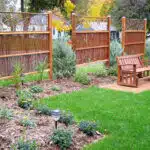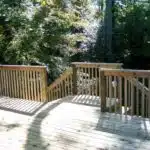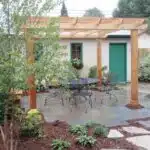Garden trellises are an essential part of any garden, providing support for plants and adding visual interest to outdoor spaces. A freestanding garden trellis is a versatile structure that can be used to support a variety of climbing plants and vines, while also serving as a decorative focal point in your garden. In this article, we will discuss the steps you need to take to build your own freestanding garden trellis.
There are many different types of garden trellises available on the market today, but building your own allows you to customize the design to suit your specific needs and preferences. Whether you are looking to create an archway, a simple panel design or something more intricate and decorative, building a freestanding garden trellis is an easy and rewarding project that can be completed in just a few hours. With the right tools and materials, anyone can build a beautiful and functional trellis that will enhance their outdoor space for years to come.
Choosing The Right Location For Your Trellis
When building a garden trellis, it is important to choose the right location. There are several factors to consider before selecting a spot for your trellis. One of the most important factors is sunlight exposure. You want to make sure that your trellis is in an area that receives ample sunlight throughout the day. This will help ensure that your plants grow properly and flourish.
Another factor to consider when choosing a location for your garden trellis is wind exposure. Strong winds can damage or even knock over your trellis, so it’s important to choose a spot that provides some protection from the wind. A good way to do this is by placing your trellis near a fence or wall, which can help shield it from strong gusts of wind.
There are both advantages and disadvantages to different locations for your garden trellis. For instance, if you place your trellis in an area with too much shade, it may not receive enough sunlight for your plants to thrive. On the other hand, if you place it in an area with too much sun exposure, your plants may become dehydrated. It’s important to find a balance between these factors when choosing where to build your garden trellis.
When determining the size and shape of your garden trellis, there are several considerations you need to take into account. By carefully considering these factors and planning accordingly, you can ensure that you build a sturdy and functional structure that will support your plants as they grow and thrive.
Determining The Size And Shape Of Your Trellis
Accurately measuring the space available for the trellis is an essential first step in the trellis construction process. The shape of the trellis should also be considered when determining building specifications, as this will affect the overall size and design of the trellis. Rectangular, square and arched designs are all common trellis shapes, each offering its own unique aesthetic. It is important to evaluate the size and shape of the trellis in order to build a trellis that is both aesthetically pleasing and structurally sound.
Measuring Space
Picture yourself standing in the middle of your garden, ready to build a freestanding garden trellis. Before you get started, it’s crucial to measure the space where you plan to install your trellis. Creative designs for garden trellises come in all shapes and sizes, so proper measurement is essential to ensure that you have enough room for your vertical gardening project.
As a garden trellis construction expert, I recommend measuring both the width and height of your available space. This step will help determine the size and shape of your trellis. It’s also important to consider any nearby plants or structures that may impact the placement of your trellis. Taking these factors into account will allow you to create a visually appealing and functional garden feature.
For those with a subconscious desire for serving others through gardening, measuring space can be an exciting opportunity to unleash creative designs for their vertical gardening projects. Don’t be afraid to experiment with unique shapes or styles that suit your personal taste and needs. Remember that with proper measurement, you can create a sturdy and attractive freestanding garden trellis that will serve as an excellent support system for all types of climbing plants.
Trellis Shape
Determining the size and shape of your trellis is an essential step in building a freestanding garden trellis. Once you’ve measured the available space, it’s time to consider different trellis shapes. A common misconception is that all trellises must be rectangular or square-shaped, but there are many benefits to experimenting with unique designs.
Different trellis shapes can add visual interest to your garden and provide a more naturalistic look. For example, an arched trellis can create a romantic and whimsical atmosphere, while a circular-shaped trellis adds a contemporary touch. Additionally, unique trellis designs can accommodate different types of climbing plants and their growth patterns, ensuring that they receive proper support as they grow.
When choosing a shape for your garden trellis, it’s important to consider both aesthetics and functionality. While a visually appealing design is crucial, the ultimate goal is to create a sturdy structure that will provide reliable support for climbing plants. By incorporating different elements such as shape and materials, you can create an attractive and functional freestanding garden trellis that will enhance the beauty of your garden.
Gathering Your Tools And Materials
For any DIY project, it’s important to gather all the necessary tools and materials ahead of time. When building a freestanding garden trellis, this step is especially crucial in ensuring that your finished product is sturdy and long-lasting. For example, let’s say you’ve decided to build your trellis using cedar wood. You’ll need to make sure you have the right saw blades and sandpaper for working with this type of wood.
Choosing materials is one of the most important steps in building a garden trellis. Cedar is a popular choice due to its natural resistance to rot and insects, but other woods like redwood or pressure-treated pine can also work well. Keep in mind that different woods will require different tools and techniques during construction. Additionally, consider what kind of plants you plan on growing on your trellis — heavier plants may require sturdier materials.
Tool maintenance is another key aspect of any DIY project. Before beginning construction on your trellis, check that all your tools are clean and in good working order. Dull blades can lead to uneven cuts or even accidents, so make sure all saws and drills have sharp blades or bits. Additionally, keep some extra sandpaper or steel wool on hand for smoothing out rough edges as you work.
It’s crucial to start off any DIY project with the right tools and materials at hand. In the next section, we’ll discuss how to cut your wood to size for your freestanding garden trellis without damaging the material or harming yourself.
Cutting Your Wood To Size
Accurately measuring your wood is crucial to building a sturdy and stable garden trellis. Before you begin cutting, take the time to measure each piece of wood twice to ensure accuracy. Use a tape measure or ruler for precise measurements and make sure to double-check before making any cuts. This will help avoid any mistakes that could compromise the integrity of your trellis.
Choosing the right type of wood for your trellis is also important. Ideally, you want a strong and durable type of wood that can withstand harsh weather conditions and support the weight of climbing plants. Cedar and redwood are popular choices due to their natural resistance to rot and decay, but they can be quite expensive. Other options include pressure-treated pine or spruce, which are more affordable but may not last as long as cedar or redwood.
Once you have measured and selected your wood, it’s time to start cutting. Remember to use safety equipment such as goggles and gloves when handling power tools. Take your time with each cut and make sure you are using the correct blade for your saw. Once all pieces have been cut, move on to sanding and preparing your wood for assembly.
Sanding And Preparing Your Wood
When constructing a freestanding garden trellis, it is important to select the right type of wood. Softwoods such as cedar, cypress, pine, and redwood are good choices. Sanding the wood prior to construction can be done manually using sandpaper or using a power sander. Sanding should be done in the direction of the wood grain and with the grain. Each sanding stage should be followed by a thorough dusting to ensure the surface is clean before the next sanding stage.
Choosing The Right Wood
As a garden trellis construction expert, I understand the importance of choosing the right wood for your project. Wood types vary in durability, strength, and appearance, which can impact the overall success of your garden trellis. When selecting wood for your project, consider factors such as weather resistance, insect resistance, and cost.
Some of the most popular wood types for garden trellises include cedar, redwood, and pressure-treated pine. Cedar and redwood are naturally resistant to rot and decay, making them ideal choices for outdoor projects. Pressure-treated pine is another option that has been treated with chemicals to resist insects and decay. However, it is important to note that this type of wood may not be safe for edible gardens.
Once you have selected your wood type, it is essential to sand and prepare it properly before finishing. Sanding helps remove any rough patches or splinters on the surface of the wood while also improving its appearance. After sanding, apply a wood finish such as stain or paint to protect against moisture damage and prolong the life of your garden trellis. With proper preparation and care, your freestanding garden trellis will provide both functional support for climbing plants and aesthetic appeal to your outdoor space.
Sanding Techniques
As a garden trellis construction expert, I know that sanding is an essential step in preparing your wood for finishing. Sanding helps to remove any rough patches or splinters on the surface of the wood, making it smoother and more visually appealing. To achieve optimal results when sanding, you will need to use the right types of sandpaper and tools.
There are different types of sandpaper that you can use for your garden trellis project. Coarse grit sandpaper is ideal for removing rough spots or blemishes on the surface of the wood. Medium-grit sandpaper is useful for smoothing out any remaining rough patches, while fine-grit sandpaper is perfect for achieving a smooth finish. You should also consider using a sanding block or an orbital sander to make the process faster and more efficient.
When it comes to sanding tools, there are several options available depending on your preference and project needs. A handheld sanding block is easy to use and provides precise control over the amount of pressure applied to the wood’s surface. An orbital sander, on the other hand, uses circular motions to cover larger areas quickly. Whatever tool you choose, be sure to apply consistent pressure while moving in a back-and-forth motion along the grain of the wood.
In summary, proper sanding techniques are crucial in preparing your wood for finishing. By selecting the right types of sandpaper and tools and applying consistent pressure along with the grain of the wood, you can achieve a smooth finish that enhances both function and aesthetic appeal in your garden trellis project.
Assembling The Frame Of Your Trellis
To assemble the frame of your garden trellis, you will need to gather all the pieces of wood that you have cut according to your design plan. Begin by laying out two of the long pieces parallel to each other on a flat surface, and then lay one of the shorter pieces across them at the top and another at the bottom. Use screws or nails to attach these pieces together securely, making sure that they are flush with each other before proceeding.
Next, take one of the remaining short pieces and place it in between the two longer side pieces, about halfway down from the top. Secure it in place with screws or nails, making sure that it is level with the other horizontal piece. Repeat this step with another short piece on the bottom half of the frame. At this point, you should have a basic rectangular frame for your trellis.
Customizing your trellis design is an important part of making it unique and personal for your garden space. Consider incorporating alternative materials such as wire mesh or bamboo poles for added texture and interest. You can also experiment with different paint colors or stains to match your existing decor or add pops of color to your garden. Remember that while functionality is essential when building a trellis, there is no reason why it can’t be aesthetically pleasing as well.
Assembling the frame of your trellis is just the beginning of creating a beautiful and functional addition to your garden area. In our next section, we will explore how adding decorative accents can elevate your trellis from simple structure to stunning focal point in any outdoor space.
Adding Decorative Accents To Your Trellis
To further enhance the beauty of your freestanding garden trellis, you may add decorative accents to it. The addition of these accents will not only make your trellis visually appealing but also functional. You can incorporate various elements such as flower arrangements or color schemes to create a unique and eye-catching design.
Flower arrangement is one of the most popular decorative accents that you can add to your trellis. You can plant flowering vines such as clematis or morning glory around the base of the structure and let them grow up through the lattice. This will create a stunning display of colors and textures that will attract both humans and pollinators alike.
Another way to add decorative accent is by using a color scheme that complements your garden’s existing palette. By painting your trellis with colors that match your flowers or foliage, you can create an integrated look in your outdoor space. Alternatively, you can choose contrasting colors for a bold statement piece.
Markdown list:
- Utilize flower arrangement to beautify your trellis
- Choose a color scheme that complements your garden’s existing palette
- Paint your trellis with colors that match or contrast with the surrounding foliage
- Create an integrated look in your outdoor space
As you consider adding decorative accents to your trellis, keep in mind that they should not only be visually appealing but also serve a functional purpose such as providing shade or support for climbing plants. Next step: attaching your trellis to the ground, which ensures stability and longevity for years to come.
Attaching Your Trellis To The Ground
Adding decorative accents to your trellis can bring some visual appeal to your garden. However, the most crucial part of building a freestanding garden trellis is its stability. Attaching your trellis to the ground ensures that it won’t topple over and damage your plants. There are various types of anchors you can use, such as ground stakes, concrete footings, or earth augers.
Ground stakes are a popular choice for securing lightweight trellises. These metal or plastic stakes have a pointed end that you drive into the soil with a hammer or mallet. Concrete footings are more robust and work well for heavier trellises. You’ll need to dig holes in the ground and pour concrete mix into them before inserting anchor bolts to hold the trellis in place. Earth augers are ideal for rocky or hard soil since they drill through the ground instead of digging.
Another way to improve the stability of your freestanding garden trellis is by raising it off the ground. A raised trellis has several benefits, such as better air circulation around your plants and easier maintenance access. Additionally, installing cross beams for extra support can help prevent wobbling or swaying caused by wind or heavy foliage on your trellis. Remember that even if you have a lightweight trellis, it’s essential to secure it properly so that it doesn’t become a hazard to people or pets who may be passing by.
Installing Cross Beams For Extra Support
When constructing a freestanding garden trellis, the selection of materials is of utmost importance. Durable, weather-resistant wood such as cedar or pressure-treated lumber should be chosen to ensure a long-lasting structure. Once the materials are selected, the next step is to accurately measure and cut the beams to the desired size. After the beams are cut, they can then be secured to the posts with galvanized screws to ensure a strong connection and provide additional support for the trellis.
Selecting Materials
As a garden trellis construction expert, I understand the importance of selecting the right materials for your project. Choosing the ideal material can make all the difference in terms of durability, stability and overall aesthetics. When installing cross beams for extra support, it is essential to consider various factors such as comparison of materials and sustainability considerations.
Firstly, let’s compare different materials that are commonly used for garden trellises. Wood, metal and PVC are three popular options available in the market. Wooden beams offer a rustic look and feel, while metal beams provide a modern touch to your garden design. PVC is another option that is lightweight and requires minimal maintenance. Each has its own advantages and disadvantages, so it’s crucial to weigh them before making a final decision.
Secondly, sustainability considerations should be taken into account when selecting the material for your garden trellis. It’s important to choose eco-friendly options to minimize environmental impact. Using recycled or repurposed materials can help promote sustainability while enhancing your garden’s aesthetics simultaneously. Sustainable options like bamboo or reclaimed wood offer an excellent alternative to traditional materials.
In summary, selecting the right material for installing cross beams for extra support plays a pivotal role in constructing an attractive yet durable garden trellis structure. Comparing different materials and considering sustainability aspects can help you make an informed decision that aligns with your personal preferences as well as environmental values.
Measuring And Cutting
As a garden trellis construction expert, I understand that installing cross beams for extra support requires careful consideration of various factors, including measuring and cutting techniques. Measuring tips are essential to ensure the accuracy of the dimensions needed for the cross beams, while cutting techniques play a significant role in achieving the desired size and shape. In this subtopic, we’ll discuss some helpful tips and techniques to help you measure and cut your cross beams accurately.
Measuring tips are crucial when it comes to installing cross beams as they directly impact the overall stability of your garden trellis structure. It’s important to measure twice and cut once to avoid any mistakes or inaccuracies. Always use a tape measure or ruler when measuring the length and width of your cross beams, and make sure to account for any angles or curves in your design. Additionally, it’s best to use a level tool when measuring to ensure that your cross beams are perfectly straight.
Cutting techniques also play an essential role in creating stable cross beams for garden trellises. When using wood as your material of choice, it’s essential to use sharp saw blades that can cut through thick lumber efficiently. A circular saw is ideal for cutting long pieces of lumber while a jigsaw is suitable for making intricate cuts. Remember always wear safety glasses and gloves when working with power tools.
In summary, measuring tips and cutting techniques are crucial components when installing cross beams for extra support in garden trellises. Following these guidelines can help you achieve accurate measurements and precise cuts which are necessary for creating stable structures that will last for years to come while ensuring safety during construction works by wearing protective gear such as gloves or safety glasses.
Securing Cross Beams
As a garden trellis construction expert, there are different techniques and considerations to ensure the stability of your garden trellis structure. Installing cross beams for extra support is one way to achieve this objective. Cross beams are crucial components in garden trellis construction as they provide additional strength and support to the overall structure. In this subtopic, we’ll discuss some helpful tips on how to secure cross beams effectively.
Alternative materials such as metal or PVC pipes can be used as cross beams. However, wood remains a popular choice due to its durability and aesthetic value. When securing cross beams, it’s essential to use appropriate hardware such as screws or bolts that can withstand the weight of the structure and external factors such as wind or rain. Additionally, it’s crucial to pre-drill holes before fastening hardware onto the cross beams to prevent splitting.
DIY cross beams require careful consideration when securing them onto vertical posts or wall mounts. It’s important to ensure that both ends of the cross beam are level before attaching them firmly onto their supports. A spirit level tool can help achieve this objective. Additionally, using angle braces or corner brackets can provide extra reinforcement for DIY cross beams and prevent any wobbling or swaying in strong winds.
In conclusion, securing cross beams requires attention to detail and proper hardware installation techniques. Incorporating alternative materials such as metal or PVC pipes is also an option but always follow manufacturer instructions when using these materials for construction purposes. By following these guidelines, you can create stable garden trellises that will last for years while ensuring safety during construction works by wearing protective gear such as gloves or safety glasses.
Creating A Lattice Pattern
After securing the foundation of your garden trellis, it is time to create a lattice pattern. Lattice patterns are essential for plant growth and can add an attractive design element to your garden. The first step in creating a lattice pattern is to measure and mark the dimensions of your trellis frame.
Once you have marked the dimensions, you can begin cutting your lattice strips to size. You can use various materials like wood, metal or PVC pipes as per your preference. Wood is a popular option due to its durability and natural aesthetics. However, if you want to experiment with other materials, metal or PVC pipes offer alternative designs that can withstand harsh weather conditions. After cutting, make sure each strip fits snugly into place before securing them with screws or nails.
Material options also extend beyond just the lattice strips themselves. You can use decorative elements like caps or finials to add flair to your trellis design. Caps and finials come in various shapes and sizes that will complement any garden style. Additionally, consider adding climbing plants like vines or roses for added beauty and practicality. With proper care, these plants will thrive on your newly built trellis.
As you finish constructing your garden trellis, consider painting or staining it for added protection against weather elements such as rain or sun rays that may cause damage over time. In the next section, we will discuss how to paint or stain your trellis effectively without causing damage during application.
Painting Or Staining Your Trellis
After creating a lattice pattern for your garden trellis, it’s time to move on to the next step: finishing it with color options and techniques. Choosing the right color and finish for your trellis can greatly enhance its overall look and durability. There are various finishing techniques available that you can choose from, depending on your preference and budget.
One of the most common finishing techniques is painting. Painting your trellis is an excellent way to add color to your garden while also protecting the wood from damage due to weather conditions. You can use any type of paint you like, but it’s recommended to use outdoor-grade paint since it’s specially formulated for outdoor use. Another popular option is staining. Staining gives your trellis a more natural look while also providing protection against weather elements.
When choosing a color for your trellis, consider the overall theme or style of your garden. If you have a rustic-themed garden, opt for earthy colors like brown or green. For a more modern look, choose bold colors like black or white. Additionally, you can also experiment with different finishes such as glossy or matte to achieve the desired effect.
Now that you’ve finished building and painting or staining your trellis, it’s time to add climbing plants to it. Adding climbing plants not only enhances the beauty of your garden but also helps in creating privacy and shading areas. Some of the best climbing plants for trellises include clematis, honeysuckle, jasmine, ivy, and roses. Choose plants that suit your climate and soil conditions for best results. Once planted, these climbing plants will add another layer of dimension and character to your already beautiful garden trellis.
Adding Climbing Plants To Your Trellis
The addition of climbing plants to your trellis is like adding the final brushstrokes to a masterpiece. It brings life and color to what was once a blank canvas, creating a stunning display that is both functional and beautiful. But with so many plant options available, it can be overwhelming to choose the right one for your garden trellis.
When choosing plants for your trellis, consider their growth habits and requirements. Some vines, such as clematis or morning glory, are annuals and will only last one season. Others, such as wisteria or honeysuckle, are perennials and will return year after year. Additionally, some vines prefer full sun while others thrive in partial shade. Take these factors into account when making your selection.
Training vines on your trellis is essential for creating an attractive display and ensuring their proper growth. Start by gently tying the stems of the plant to the trellis with twine or wire every few inches along the stem. As it grows taller, continue securing it to the structure until it reaches its full height. Be sure not to tie it too tightly or damage could occur.
Maintenance tips for your climbing plants include regular watering and fertilizing during their growing season. Deadheading spent blooms will encourage new growth and promote flowering throughout the season. Pest control measures may also be necessary if insects pose a threat to your plants’ health.
Transition: Now that you’ve successfully trained your vines on your garden trellis and they’re flourishing beautifully, let’s talk about how to keep them healthy with proper maintenance and care.
Trellis Maintenance And Care
Regular maintenance and care is crucial for the longevity and functionality of your garden trellis. Regular cleaning of your trellis will help prevent buildup of debris, mold, and mildew. Use a soft-bristled brush or a cloth with soapy water to gently clean the trellis. Rinse it thoroughly with water and allow it to air dry before using it again.
Preventative measures can also be taken to maintain the health of your trellis. One way is to apply a protective coating such as paint or sealant to the wood or metal material used in constructing the trellis. This helps protect against weather damage such as rust, corrosion, or rot.
Another preventative measure is to inspect your trellis regularly for any signs of wear and tear. Check for loose screws or bolts, cracked wood, or bent metal pieces. Catching these issues early on can prevent further damage and save you from having to replace the entire structure. By implementing regular maintenance and preventative measures, you can ensure that your garden trellis remains sturdy and functional for years to come.
To troubleshoot common issues that may arise with your garden trellis, continue reading our next section about identifying and fixing problems with your trellis.
Troubleshooting Common Issues
Even the most experienced gardeners can run into issues when building a freestanding garden trellis. Luckily, there are common solutions to these problems that can be easily implemented.
One issue that may arise is the trellis leaning or tilting to one side. This is often caused by uneven ground or incorrect installation of the support beams. To fix this issue, start by checking if the ground is level and adjusting the support beams accordingly. If necessary, add additional support beams or stakes for added stability.
Another common issue is plants not properly attaching to the trellis. This can be due to a lack of support wires or insufficient space between them. To remedy this, add more support wires and/or increase the distance between existing ones. If your plants are still having trouble attaching, consider DIY alternatives such as tying them with twine or using clips.
Finally, some gardeners may experience issues with their trellis becoming damaged over time due to weather conditions or wear and tear. In these cases, it’s important to regularly inspect and maintain your trellis by tightening screws and replacing any damaged parts as needed.
By addressing these common issues and implementing simple solutions, you’ll be able to enjoy your beautiful garden trellis for years to come!
Enjoying Your Beautiful Garden Trellis
After successfully building your garden trellis, it’s time to enjoy the outdoor decor that it brings to your garden. A freestanding garden trellis can serve multiple purposes such as providing support for climbing plants or adding aesthetic value. To fully enjoy your new garden trellis, consider selecting the right plants to complement its design.
When it comes to plant selection for your garden trellis, there are plenty of options available depending on your preferences and climate. Climbing roses, clematis, and honeysuckle are popular choices due to their vibrant colors and fragrant scents. Additionally, ivy and other foliage plants can create a beautiful green wall effect on the trellis.
To further enhance the beauty of your garden trellis, you can incorporate outdoor decor elements such as hanging baskets or decorative lighting. These additions not only add visual interest but also create a cozy ambience for outdoor gatherings.
Incorporating the right plant selection and outdoor decor elements will help you fully enjoy the beauty of your new garden trellis. By taking these steps, you’ll be able to create an inviting space that not only enhances your home’s exterior but also provides a peaceful haven for relaxation and enjoyment.
Conclusion
A garden trellis can add beauty and functionality to any outdoor space. By following the steps outlined in this article, you can build a freestanding garden trellis that will not only provide support for climbing plants but also enhance the aesthetic appeal of your garden.
When choosing the location for your trellis, make sure it is an area that receives adequate sunlight and has enough space to accommodate the size and shape of your structure. Determine the dimensions of your trellis based on the height and width of your climbing plants. Ensure that you have all the necessary tools and materials before beginning construction.
Cutting and sanding your wood to size is essential for creating a smooth surface that will be aesthetically pleasing as well as comfortable for climbing plants. Adding climbing plants to your trellis will require some patience and maintenance, but with proper care, they will flourish beautifully.
For example, imagine a backyard garden with a stunning freestanding garden trellis covered in vibrant purple wisteria vines. The fragrance of the flowers fills the air as you sit on a nearby bench, admiring their beauty. This is just one example of how a well-built garden trellis can transform an ordinary outdoor space into a breathtaking oasis.
As an expert in garden trellis construction, I encourage you to take pride in building your own unique structure while enjoying the benefits of increased plant growth, improved aesthetics, and enhanced overall value of your property. With proper planning and execution, constructing a beautiful freestanding garden trellis can be both rewarding and enjoyable.
Image Credits
- “City gives way to a suburban freestanding Olive Garden” by Eric Fischer (featured)












![How To Repair Rotted Wood 12 Texture : Altario Buick Estate Wagon : Rotting Faux Wood Paneling [1 of 2]](https://green-life.blog/wp-content/uploads/2023/05/z1CersK-gCjq-150x150.jpg.webp)
















